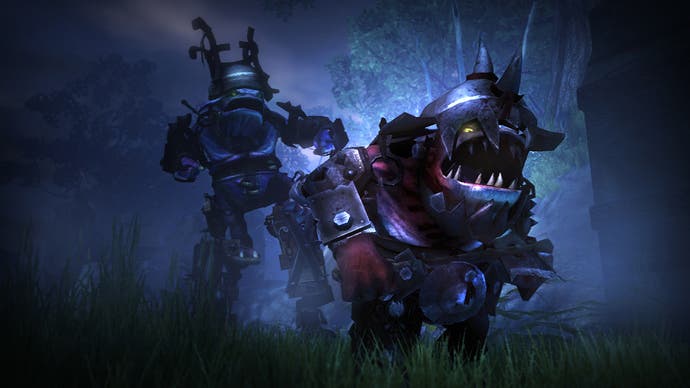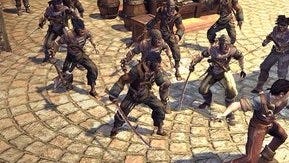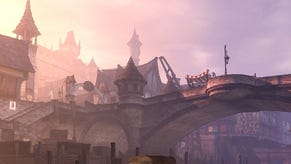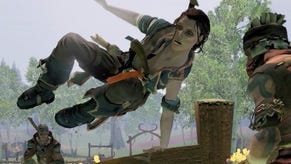Fable II
Heroic.
Fairy tales may be primarily about getting married and shoving elderly eccentrics into ovens, but more often than not, there's a thread of revolutionary spirit running through them as well. Along with the enchanted footwear and talking mirrors, there's a corrupt king who requires overthrowing, or a cruel and mysterious grip on the land that needs to be broken. It makes sense, then, that alongside the high adventure and tumbledown castles of Fable II, in amongst the midnight intrigue and haunted swamps, there's a similar spark of revolution at work. But this is regime-change at its most fundamental, and Lionhead's fascination with the world of choices and consequences has lead it to topple some of gaming's most accepted idols. Fable II explores what happens when a game does away with most forms of punishment, and does nothing but reward its players from start to finish. The results are astonishing.
It's worth stepping away from the tried and tested Pavlovian mechanics that games have inherited from the coin-crunching arcades to consider what Lionhead is proposing. Almost every game ever made has reinforced its rules with penalties: if you fight and lose, you're killed; if you go off and explore, you get lost; if you're spotted when you're meant to be hiding, you're deported back to the start. It's a strategy that undoubtedly works - many of gaming's finer moments are often interlinked with its harshest challenges - but there's also no escaping the fact that when it all goes wrong you're often treated like a lab monkey undergoing a rather cruel experiment: you may really want that banana, but the chances are you're going to get a lot of electric shocks first.
Fable II, to continue this somewhat tenuous analogy, would rather shower you with bananas as often as it possibly can. The biggest surprise is that the game's inherent generosity never feels gratuitous, even when it's overturning many games' most fundamental design principles. Fable II's glowing breadcrumb trail leads you ever onwards to your next objective, but even though you can't get lost it still allows for deep exploration. It also makes you consider why so many games force you to traipse around in circles or click on every NPC you meet to access the next mission. Similarly, the game's death-free combat makes you wonder why you've been settling for mere survival all these years when you can spend your time working towards mastery instead. These ideas were originally introduced to Fable II so that it would be more accessible to non-gamers, and while that's undoubtedly been achieved, it hasn't excluded the more experienced player either.

Written down, this sounds like sacrilege. That breadcrumb trail is hardly new, after all, calling to mind the neon arrows of Perfect Dark Zero or even the first level of Halo, but Albion is actually an admirably intuitive place to get around - at any moment, you can switch off the glowing path and discover that there are more than enough signposts, way-markers, and other subtle environmental details to tell you where you're going. In fact, the game's controversial pathfinding system really comes into its own when you realise you can ignore it as much as you want, and what was initially patronising becomes empowering. Why not follow your dog for half an hour - he's there to lead you off the beaten path, after all - and head into the wilderness to discover the game's wealth of secret chests and side-quests? Buy a house, get married, have children, kill them all and smash the place up: whatever you choose to explore, the path will be quietly waiting behind you when you go back to the narrative, pointing the way to your next objective as it whimsically zigzags across paving stones, mossy roads, swampland and farmers' meadows.
And when you do follow it, you'll find yourself in the middle of a game that manages to offer you all the good bits of adventuring and few of the bad. Following Fable II's path of least resistance leads you through an expertly paced trail of combat and quests, spectacle and challenge, with no roadblocks in between. You never find yourself having to tease out the next chunk of story.
Fable II's approach to combat is equally idiosyncratic. While the one-button fighting has garnered the most headlines, it's the game's reluctance to punish you for failure that really marks it out: if you're downed in battle, it's not back to the last checkpoint. Instead you lose a few experience points, before surging heroically back to life, health-bar refilled, with barely a pause in the action. You expect this kind of treatment in LEGO Star Wars, but aren't role-players supposed to grind?

Besides allowing inexperienced players to muddle through any situation, this allows the designers to string together truly mammoth battles. Yet far from rendering the combat toothless by taking out the penalty of restarts, the game provides another, deeper challenge - get through the fights looking as good as you can. While you can one-button your way through if you wish, the real pleasures lie in mixing it up - maximising the experience orbs received by pulling off acrobatic flourish moves and timed attacks, switching between area strikes and targeted magic, softening an enemy up with your sword before finishing them off up close with your rifle.









